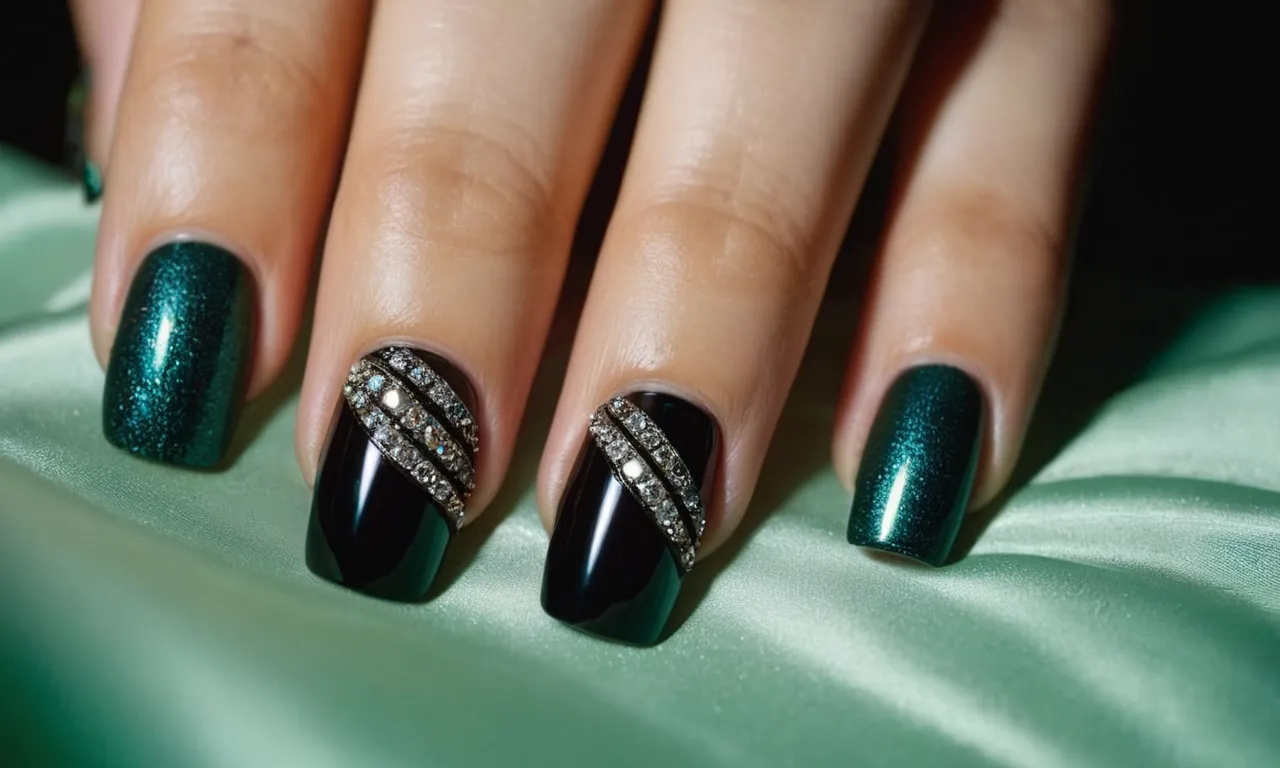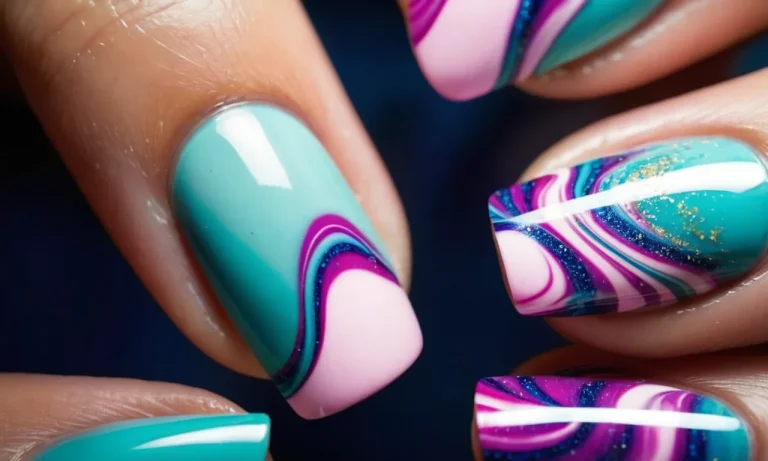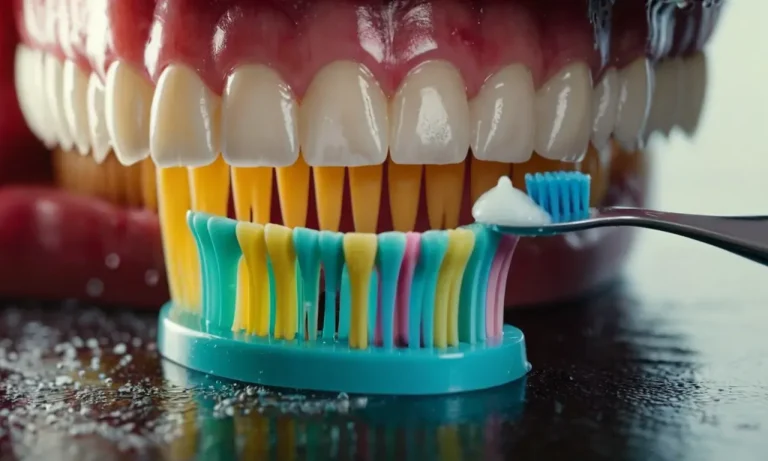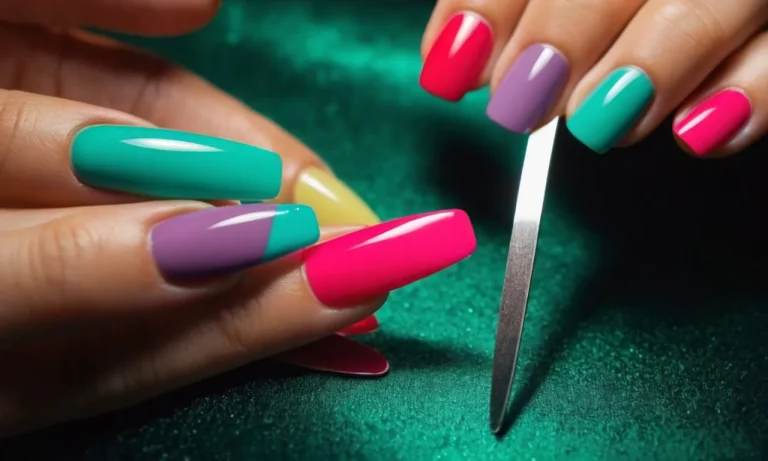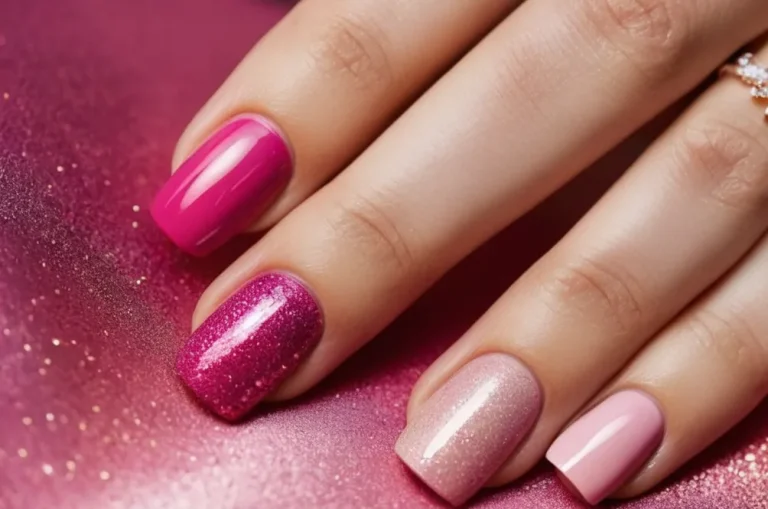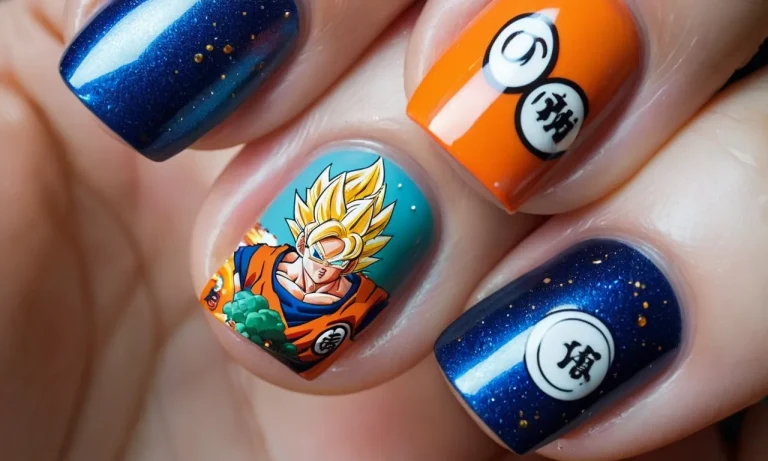Glass Nails Vs Acrylic Nails: Which Is Better For You?
In the world of nail art, glass and acrylic nails are two popular options for achieving beautiful, durable manicures. But what’s the difference between these two materials, and which is better? Keep reading as we compare and contrast glass vs acrylic nails.
If you’re short on time, here’s a quick answer: Glass and acrylic nails both allow for creative nail looks that last 2-3 weeks on average. Glass nails are more natural looking but take longer to apply. Acrylics set faster but can damage the nails over time.
Overall, glass nails are the healthier choice if you’re patient during application.
Appearance of Glass vs Acrylic Nails
Glass nails look more natural
Glass nails have a gorgeous, natural-looking finish that is nearly indistinguishable from real nails. The glass powder used creates a smooth, sleek surface and transparency that looks polished and healthy. Acrylic nails can sometimes look bulky or overly white at the tips.
With glass nails, you don’t have to worry about that artificial-looking acrylic hue. The glass powder blends into the natural nail seamlessly. Many people find glass nails have a real “wow” factor and get tons of compliments on how real their nails look.
The transparent finish also allows your natural nail to show through beautifully.
Glass nails tend to have a thinner, lighter feel as well. Acrylic nails can be quite thick and heavy, while glass has a feather-light finish. This allows your natural nails to breathe and reduces damage. If you like a natural look with plenty of shine and strength, glass nails are the way to go.
From French manicures to nude tones, glass powder creates a polished yet understated appearance.
Acrylics offer more design options
While glass nails excel at creating a clean, natural look, acrylics offer more versatility when it comes to shapes, lengths, and designs. With acrylic powder, nail technicians can sculpt extended nails and dramatic stiletto or coffin shapes easily.
The thickness of acrylic also makes it possible to create long, durable nails. Acrylic lends itself better to nail art as well with its ability to hold forms and take on color. Everything from ombre to chrome powder to 3D acrylic art is possible.
If you want to go bold and play with different nail styles, acrylic gives you more freedom. Length, shape, and decoration are nearly endless! Acrylic also comes in every color imaginable, from reds and nudes to glitters and neon brights. You can match any outfit or mood.
Of course, acrylic’s versatility comes with a downside – it can sometimes appear artificial if not applied properly. But for nail art potential, dramatic shapes, and colorful creativity, acrylic can’t be beaten!
Durability and Longevity
When considering longevity between glass nails and acrylics, there are a few key factors to weigh. Both nail enhancement options can last around 2-3 weeks on average with proper application and at-home care. However, they do have some differences when it comes to durability over time.
Both types last 2-3 weeks on average
With proper application by a licensed nail technician, both glass and acrylic nail enhancements should remain intact for 2-3 weeks on average before needing infills or removal. Maintaining the enhancements with regular touch-ups every 2-3 weeks allows for long-lasting wear.
Proper at-home care is also key for longevity. Using cuticle oil daily, avoiding excessive water exposure, wearing gloves for cleaning, and filing away lift as it occurs can all help glass or acrylic nails last their expected 2-3 week wear time.
Glass is more flexible while acrylics are rigid
A key difference between glass and acrylic nails is flexibility – glass nail material is more flexible while acrylics are quite rigid. This flexibility lends itself to glass nail enhancements withstanding more bend without cracking or popping off.
Acrylic nails may be more prone to cracks, breaks, and pops because they are rigid. If the natural nail flexes or bends underneath, the acrylic is less likely to flex with it which can lead to damage. This may translate to more repairs needed over time compared to stronger glass nails.
That said, the rigidity of acrylics also offers durability for long length. Glass nails may have issues sustaining very long length extensions due to flexibility, while sturdy acrylics support extra length better. For very long nails, acrylics hold up well.
When it comes to polish and design, both enhancement types offer 2+ weeks of durable wear for lacquer. The longevity has more to do with proper polish application and top coat than the enhancement material underneath when done correctly.
In the battle of glass vs acrylic nails for durability over time, glass nails win for flexibility while acrylics take the title for sustaining long lengths without issue for most wearers. Knowing your lifestyle and nail needs can help determine which material offers better longevity of wear.
Application and Removal
Glass nails take longer to apply
The application process for glass nails is more intricate compared to acrylics. Glass nails require careful filing and shaping to get a smooth finish. The technician layers the glass powder and liquid monomer to build the extension from the natural nail tip.
This process is repeated until the desired length and shape is achieved. According to industry experts, a full set of glass nails can take 60-90 minutes or longer to apply compared to 45-60 minutes for a acrylic set.
The curing process for glass nails also tends to be longer. After each layer, the nails must be cured under LED or UV lamps for 1-2 minutes before filing and adding the next layer. With more layers involved, this builds up the total application time.
However, the results are a super glossy and durable nail that lasts 3-4 weeks on average.
Soaking is required to remove acrylics safely
Removing acrylic nails requires a 20-30 minute soak in pure acetone-based nail polish remover before gently filing off the enhancements from the natural nail. Soaking softens the acrylic or gel polish layers for safer removal.
Attempting to peel off acrylics without softening can damage the natural nails by ripping off layers of keratin protein that protect nail beds.
According to NailcareHQ, acrylic and gel polish removers contain ‘solvents’ that break down the bonds of the artificial enhancements. By filling a bowl with remover and submerging nails for 20-30 minutes, the enhancements loosen their grip from the natural nail and can be gently pushed off without ripping off pieces of the real nail.
This soak-off removal process may irritate skin so Butter London recommends cleaning nails thoroughly after soaking. Using cuticle oil can also help hydrate and protect nail beds. With glass nails, the application is more gradual but the removal requires the same level of care and patience to prevent natural nail damage.
Cost Comparison
Glass nails are more expensive upfront
When considering the upfront costs, glass nails tend to be more expensive than acrylic nails. A full set of glass nails can cost $80-150 depending on your location and the salon you visit. This is because glass nails require more time and skill to apply properly.
The glass powder and monomer bonding agent used are also more costly materials. However, the end result is a super glossy, durable nail that looks like a natural extension of your own nail.
In comparison, a full set of acrylic nails costs $50-100 on average. The acrylic powder and liquid monomer are cheaper than the glass nail equivalents. Application time is also faster since acrylic sets more quickly.
So while acrylics are definitely the budget-friendly option, glass nails offer unparalleled shine and transparency for those willing to invest more initially.
But less damaging for natural nails over time
Though more expensive at first, glass nails cause less damage to the natural nail over time. Acrylic adheres very firmly to the natural nail, requiring heavy filing for removal. This filing thins and weakens nails. Acrylics also limit oxygen supply to the nail bed, increasing infection risk.
With long term wear, acrylics can cause nail plate separation and other issues.
Glass nails have a flexible, gel-like bond to the natural nail. Soak-off removal is much gentler, requiring little to no filing. The permeability of the bond allows nails to breathe as well. This means glass nails can be worn for months longer than acrylics before needing replacement.
Less reapplication equals less cumulative damage and lower costs in the long run. The Investment Association of China reports the average woman spends $216 annually on nail services. Opting for glass over acrylic could save at least $100 per year from the reduced need for fills and replacements.
| Nail Type | Avg. Initial Set Cost | Reapplication Frequency | Avg. Annual Cost |
|---|---|---|---|
| Glass Nails | $100 | Every 3 months | $400 |
| Acrylic Nails | $75 | Every 2 months | $450 |
While glass nails require a higher upfront investment, their durability and gentle removal reduce costs over time compared to high-maintenance acrylics. For glamorous nails that actually nurture the natural nail, glass is worth the splurge!
Health and Safety Considerations
When it comes to acrylic and glass nails, it’s important to consider the health and safety impacts of each option. Here’s an overview of some of the key points:
Acrylics can cause nail damage if applied incorrectly
Acrylic nails require application of liquid and powder products that chemically bond to the natural nail. If not applied properly, acrylics can cause a number of issues:
- Overfiling the natural nail – Filing down the surface too much can weaken nails and increase risk of breaks.
- Lifting – Improper application can lead to lifting or peeling. This can rip layers off the natural nail.
- Allergic reactions – Some people may be allergic to acrylic ingredients like methacrylate.
To avoid damage, it’s important to go to a qualified professional and follow proper nail care between appointments. Poor technique or maintenance can wreak havoc on your natural nails!
Glass is safer for natural nails in the long run
Glass nails have gained popularity as a safer alternative to acrylics. Here are some of the benefits:
- Less risk of damage – Since glass nails are cured under LED light instead of bonded chemically, they don’t require as much filing of the natural nail.
- Help nails grow – The added strength can help weak or damaged nails grow out under the glass protecting overlay.
- Easier to remove – Glass nails can be soaked off, reducing chances of ripping off layers of natural nail.
While no type of artificial nail is completely risk-free, glass is thought to be one of the safer enhancement options. Lessprep work on the natural nail means you’re less likely to cause long-termproblems. When cared for properly, glass can be a good choice for maintaining strong and healthy nails.
At the end of the day, it comes down to choosing the right nail technician and caring for your nails properly between appointments. Both acrylics and glass come with risks if applied incorrectly. But glass nails may provide more protection for your natural nails in the long run.
Conclusion
When choosing between glass vs acrylic nails, consider your priorities in terms of appearance, longevity, cost, and health safety. Glass nails allow for a more natural look and are safer for your natural nails over time. But acrylics offer more design versatility and are faster to apply.
Consult a skilled nail technician to determine which option may be right for you.

